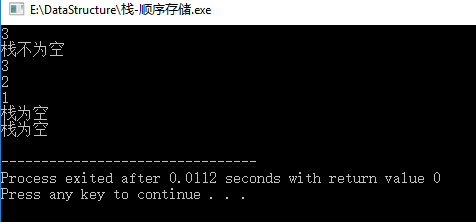栈的简单实现(1)-数组实现
引言
栈(stack)是一种被广泛使用的线性数据结构,它只允许在表的一端进行插入或删除操作,因而栈也可以被称作为操作受限的线性表 。在栈中,允许插入或删除的一端称作栈顶(top)不允许插入和删除的另一端称作栈底(bottom);
示意图如下:

此文借助数组简单地实现栈及其基本操作。
代码如下:

#define MaxSize 100 typedef struct{ int data[MaxSize]; int top; }SeqStack;
注:这里假设栈中储存的是整型 (int) 的数据
基本操作
1.栈的初始化

void init(SeqStack* s) { s->top = -1; //数组下标从0开始,因而这里表示栈为空 }
2.进栈

void push(SeqStack* s, int x) { if(s->top<MaxSize-1) //栈未满才能进栈 s->data[++(s->top)] = x; }
3.出栈

int pop(SeqStack* s) { if(s->top>-1) //栈不为空才能出栈 return (s->data[s->top--]); }
4.清空栈

void clear(SeqStack* s) { s->top = -1; }
5.判断栈是否为空

bool isEmpty(SeqStack* s) { if(s->top==-1){ return true; }else{ return false; } }
6.求栈的长度

int length(SeqStack* s) { return (s->top+1); }
进行测试:

int main(void) { SeqStack s; init(&s); push(&s, 1); push(&s, 2); push(&s, 3); printf("%d\n", length(&s)); if(isEmpty(&s)){ printf("栈为空\n"); }else{ printf("栈不为空\n"); } printf("%d\n", pop(&s)); printf("%d\n", pop(&s)); printf("%d\n", pop(&s)); if(isEmpty(&s)){ printf("栈为空\n"); }else{ printf("栈不为空\n"); } push(&s, 3); clear(&s); if(isEmpty(&s)){ printf("栈为空\n"); }else{ printf("栈不为空\n"); } return 0; }
测试结果:

完整代码

#include<stdio.h> #define MaxSize 100 typedef struct{ int data[MaxSize]; int top; }SeqStack; void init(SeqStack* s); bool isEmpty(SeqStack* s); void push(SeqStack* s, int x); int pop(SeqStack* s); void clear(SeqStack* s); int length(SeqStack* s); int main(void) { SeqStack s; init(&s); push(&s, 1); push(&s, 2); push(&s, 3); printf("%d\n", length(&s)); if(isEmpty(&s)){ printf("栈为空\n"); }else{ printf("栈不为空\n"); } printf("%d\n", pop(&s)); printf("%d\n", pop(&s)); printf("%d\n", pop(&s)); if(isEmpty(&s)){ printf("栈为空\n"); }else{ printf("栈不为空\n"); } push(&s, 3); clear(&s); if(isEmpty(&s)){ printf("栈为空\n"); }else{ printf("栈不为空\n"); } return 0; } void init(SeqStack* s) { s->top = -1; //数组下标从0开始,因而这里表示栈为空 } bool isEmpty(SeqStack* s) { if(s->top==-1){ return true; }else{ return false; } } void push(SeqStack* s, int x) { if(s->top<MaxSize-1) //栈未满才能进栈 s->data[++(s->top)] = x; } int pop(SeqStack* s) { if(s->top>-1) //栈不为空才能出栈 return (s->data[s->top--]); } void clear(SeqStack* s) { s->top = -1; } int length(SeqStack* s) { return (s->top+1); }



 浙公网安备 33010602011771号
浙公网安备 33010602011771号